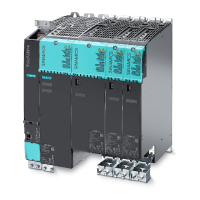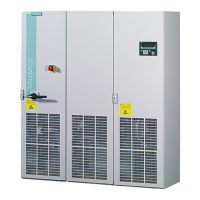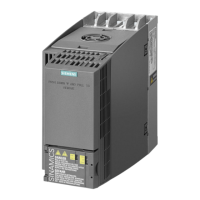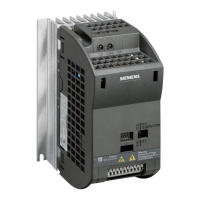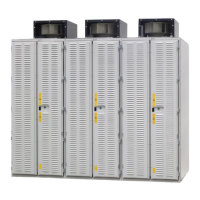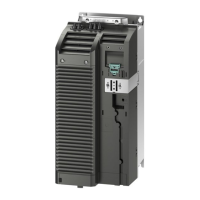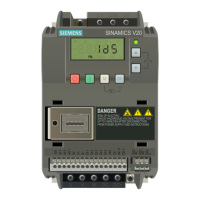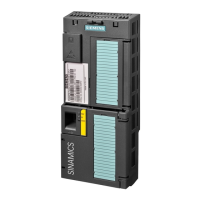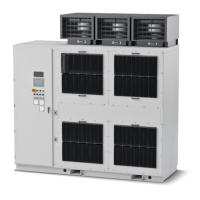SINAMICS G150
Engineering Information
SINAMICS Engineering Manual – November 2015
Ó Siemens AG
313/528
Parallel-connected converters
Out-
put
[kW]
Converter
SINAMICS
G150
Version A
Type
6SL3710-…
Weight
(stan-
dard
model)
[kg]
Line supply connection Motor connection Cabinet
grounding
Recom
cross-section
1)
IEC
[mm
2
]
Maximum cable
cross-section
M12
fixing
screw
(no. of
holes)
Recommended
cross-section
1)
IEC
[mm
2
]
Maximum cable
cross-section
screw
(no. of
holes)
screw
(no. of
holes)
Re-
marks
IEC
[mm
2
]
IEC
[mm
2
]
380 V – 480 V 3AC
630 2GE41-1AA3 1700 2x240 4x240 (2) 2x185 4x240 (2) (2)
710 2GE41-4AA3 1710 3x185 4x240 (2) 2x240 4x240 (2) (10) Busbar
900 2GE41-6AA3 2130 4x150 8x240 (4) 2x240 4x240 (2) (16) Busbar
500 V – 600 V 3AC
630 2GF38-6AA3 1700 2x185 4x240 (2) 2x150 4x240 (2) (2)
710 2GF41-1AA3 1700 2x240 4x240 (2) 2x185 4x240 (2) (2)
1000 2GF41-4AA3 2620 3x185 8x240 (4) 2x240 6x240 (3) (18) Busbar
660 V – 690 V 3AC
1000 2GH41-1AA3 1700 2x240 4x240 (2) 2x185 4x240 (2) (2)
1350 2GH41-4AA3 2620 3x185 8x240 (4) 3x150 6x240 (3) (18) Busbar
1500 2GH41-5AA3 2700 4x150 8x240 (4) 3x185 6x240 (3) (18) Busbar
1750 2GH41-8EA3 3010 4x150 8x240 (4) 3x185 6x240 (3) (18) Busbar
1950 2GH42-0EA3 3010 4x185 8x240 (4) 3x240 6x240 (3) (18) Busbar
2150 2GH42-2EA3 3070 4x185 8x240 (4) 3x240 6x240 (3) (18) Busbar
2400 2GH42-4EA3 3860 4x240 8x240 (4) 4x185 6x240 (3) (18) Busbar
2700 2GH42-7EA3 4580 4x240 8x240 (4) 3x185 6x240 (3) (18) Busbar
1) The recommendations for the North American market in AWG or MCM must be taken from the appropriate NEC (National
Electrical Code)/CEC (Canadian Electrical Code) standards.
Note:
The recommended and maximum connection cross-sections for the SINAMICS G150 parallel converters refer in
each case to one of the two rectifier sections or to one of the two inverter sections.
Exception: The recommended and maximum connection cross-sections for the parallel converter with output power
rating 2700 kW refer in each case to one of the two rectifier sections and to one of the three inverter sections.
5.4.2 Required cable cross-sections for line and motor connections
Generally speaking, unshielded cables can generally be used to make the line connection. 3-wire or 4-wire three-
phase cables should be used wherever possible. By contrast, it is always advisable to use shielded cables between
the converter and motor and, in the case of drives in the higher output power range, symmetrical 3-wire, three-phase
cables, and to connect several cables of this type in parallel where necessary. There are basically two reasons for
this recommendation:
This is the only way in which the high IP55 degree of protection can be achieved for the motor terminal box without
problems because the cables enter the terminal box via glands and the number of possible glands is limited by the
geometry of the terminal box. Therefore single cables are less suitable.
With symmetrical, 3-wire, three-phase cables, the summed ampere-turns over the cable outer diameter are equal to
zero and they can be routed in conductive, metal cable ducts or racks without any significant currents (ground current
or leakage current) being induced in these conductive, metal connections. The danger of induced leakage currents
and thus of increased cable-shield losses increases with single-wire cables.
The required cable cross-section depends on the amperage which flows through the cable. The permissible current
loading of cables is defined, for example, in IEC 60364-5-52. It depends on ambient conditions such as the
temperature, but also on the routing method. An important factor to consider is whether cables are routed singly and
are therefore relatively well ventilated, or whether groups of cables are routed together. In the latter instance, the
cables are much less well ventilated and might therefore heat one another to a greater degree. For the relevant
correction factors applicable to these boundary conditions, please refer to IEC 60364-5-52. The table below provides
a guide to the recommended cross-sections (based on IEC 60364-5-52) for PVC-insulated, 3-wire copper and
aluminum cables, a permissible conductor temperature of 70°C (e.g. Protodur NYY or NYCWY) and an ambient
temperature of 40°C.
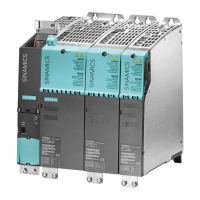
